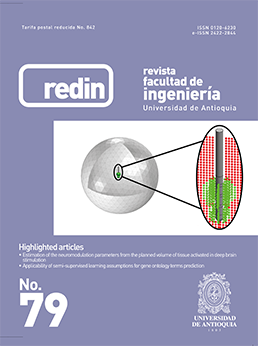Data envelopment analysis and Pareto genetic algorithm applied to robust design in multiresponse systems
DOI:
https://doi.org/10.17533/udea.redin.n79a11Keywords:
Taguchi methods, Pareto genetic algorithms, data envelopment analysis, robust designAbstract
This paper shows the use of Data Envelopment Analysis (DEA) to rank and select the solutions found by a Pareto Genetic Algorithm (PGA) to problems of robust design in multiresponse systems with many control and noise factors. The efficiency analysis of the solutions using DEA shows that the PGA finds a good approximation to the efficient frontier. Additionally, DEA is used to determine the combination of a given level of mean adjustment and variance in the responses of a system, so as to minimize the economic cost of achieving those two objectives. By linking that cost with other technical and/or economic considerations, the solution that best matches a predefined level of quality can be more sensibly selected.
Downloads
References
G. Taguchi, Systems of experimental design, 4th ed. Dearborn, USA: American Supplier Institute, 1991.
T. Robinson, C Borror and R. Myers, “Robust Parameter Design: A Review”, Quality & Reliability Engineering Internation, vol. 20, no. 1, pp. 81-101, 2004.
H. Allende, E. Canessa and J. Galbiati, Diseño de experimentos industriales, 1st ed. Valparaíso, Chile: Universidad Técnica Federico Santa María, 2005.
H. Allende, D. Bravo and E. Canessa, “Robust design in multivariate systems using genetic algorithms”, Quality & Quantity, vol. 44, no. 2, pp. 315-332, 2010.
S. Maghsoodloo and C. Chang, “Quadratic loss functions and signal-to-noise ratios for a bivariate response”, Journal of Manufacturing Systems, vol. 20, no. 1, pp. 1-12, 2001.
W. Wan and J. Birch, “Using a modified genetic algorithm to find feasible regions of a desirability function”, Quality & Reliability Engineering International, vol. 27, no. 8, pp. 1173-1182, 2011.
J. Holland, Adaptation in Natural and Artificial Systems: An Introductory Analysis with Applications to Biology, Control, and Artificial Intelligence, 1st ed. Ann Arbor, USA: MIT Press, 1974.
C. Lin, C. Anderson, M. Hamada, L. Moore and R. Sitter, “Using Genetic Algorithms to Design Experiments: A Review”, Quality & Reliability Engineering International, vol. 31, no. 2, pp. 155-167, 2015.
B. Forouraghi, “A Genetic Algorithm for Multiobjective Robust Design”, Applied Intelligence, vol. 12, no. 3, pp. 151-161, 2000.
E. Canessa, G. Bielenberg and H. Allende, “Robust Design in Multiobjective Systems using Taguchi’s Parameter Design Approach and a Pareto Genetic Algorithm”, Rev. Fac. Ingeniería Univ. Antioquia, no. 72, pp. 73-86, 2014.
A. Charnes, W. Cooper and E. Rhodes, “Measuring the Efficiency of Decision Making Units”, European Journal of Operational Research, vol. 2, no. 6, pp. 429-444, 1978.
D. Aigner, C. Lovell and P. Schmidt, “Formulation and Estimation of Stochastic Frontier Production Function Models”, Journal of Econometrics, vol. 6, no. 1, pp. 21- 37, 1977.
F. Ortiz, J. Simpson, J. Pigniatello and A. Heredia, “A Genetic Algorithm Approach to Multiple - Response Optimization”, Journal of Quality Technology, vol. 36, no. 4, pp. 432-450, 2004.
E. Castillo, D. Montgomery and D. McCarville, “Modified Desirability Functions for Multiple Response Optimization”, Journal of Quality Technology, vol. 28, no. 3, pp. 337- 345, 1996.
M. Farrell, “The Measurement of Productive Efficiency”, Journal of the Royal Statistical Society Series A General, vol. 120, no. 3, pp. 253-290, 1957.
W. Cooper, L. Seiford and K. Tone, Data Envelopment Analysis: A Comprehensive Text with Models, Applications, References and DEA-Solver Software, 2nd ed. New York, USA: Springer, 2007.
R. Färe, S. Groskopf, C. Lovell, The Measurement of Efficiency of Production, 1st ed. Boston, USA: KluwerNijhoff Publishing Co., 1985.
E. Canessa, C. Droop and H. Allende, “An improved genetic algorithm for robust design in multivariate systems”, Quality & Quantity, vol. 46, no. 2, pp. 665-678, 2011.
W. Vandenbrande, “Make love, not war: Combining DOE and Taguchi”, in ASQ´s 54th Annual Quality Congress Proceedings, Indianapolis, USA, 2000, pp. 450-456.
W. Vandenbrande, “SPC in paint application: Mission Impossible?”, in ASQ’s 52nd Annual Quality Congress Proceedings, Indianapolis, USA, 1998, pp. 708-715.
K. Ranjit, Design of Experiments Using the Taguchi Approach: 16 Steps to Product and Process Improvement, 1st ed. New York, USA: J. Wiley & Sons, 2001.
K. Deb, L. Thiele and E. Zitzler, “Comparison of Multiobjetive Evolutionary Algorithms: Empirical Results”, Evolutionary Computation, vol. 8, no. 2, pp. 173-195, 2000.
R. Myers, D. Montgomery and Christine M. Anderson, Response surface methodology: process and product optimization using designed experiments, 2nd ed. New York, USA: J. Wiley & Sons, 2002.
Downloads
Published
How to Cite
Issue
Section
License
Copyright (c) 2016 Revista Facultad de Ingeniería Universidad de Antioquia

This work is licensed under a Creative Commons Attribution-NonCommercial-ShareAlike 4.0 International License.
Revista Facultad de Ingeniería, Universidad de Antioquia is licensed under the Creative Commons Attribution BY-NC-SA 4.0 license. https://creativecommons.org/licenses/by-nc-sa/4.0/deed.en
You are free to:
Share — copy and redistribute the material in any medium or format
Adapt — remix, transform, and build upon the material
Under the following terms:
Attribution — You must give appropriate credit, provide a link to the license, and indicate if changes were made. You may do so in any reasonable manner, but not in any way that suggests the licensor endorses you or your use.
NonCommercial — You may not use the material for commercial purposes.
ShareAlike — If you remix, transform, or build upon the material, you must distribute your contributions under the same license as the original.
The material published in the journal can be distributed, copied and exhibited by third parties if the respective credits are given to the journal. No commercial benefit can be obtained and derivative works must be under the same license terms as the original work.










 Twitter
Twitter